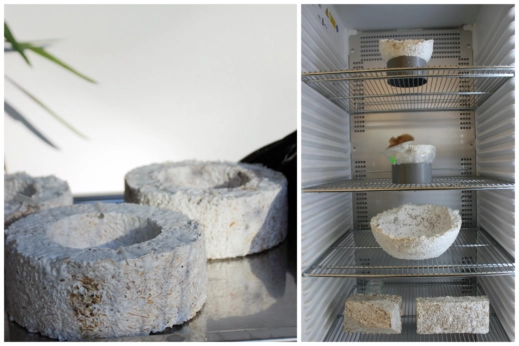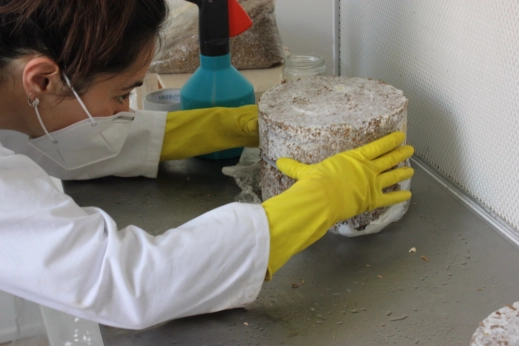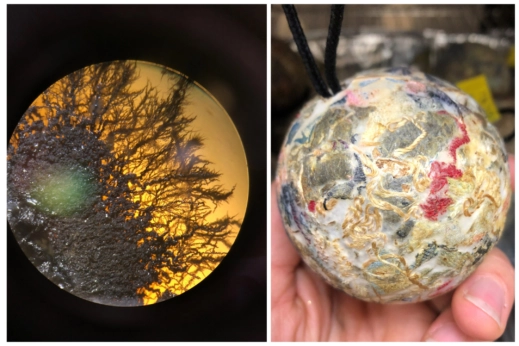Fungi offer a low-impact, full-circle solution to hazardous waste management.

Fungus is usually a good sign of things going bad. But it can also indicate good things happening to very bad stuff.
For Audrey Speyer, founder of PuriFungi, seeing fungi blooming on cigarette butts is proof that they’re at work, doing what they do best: decomposing matter. Her Belgian start-up cultivates mycelium—the thread-like root structure of fungus—using the plastic- and toxin-laden stubs as fodder.
As digestive enzymes break down the hazardous mix, the mycelium grows into a lightweight, styrofoam-like material that gets molded into ashtrays. Distributed at music festivals and public events and in municipalities throughout Belgium, France and Luxembourg, the upcycled product, which looks like a hollowed-out wheel of camembert, brings the process full circle by reining in the world’s most discarded waste item.
Since the dawn of civilization, humans have harnessed the remarkable power of fungi—an entire kingdom of multicellular organisms that includes mold, mushrooms and truffles—to digest complex organic matter into simpler structures. Yeast feeds on sugars, for example, to produce alcohol, while certain mold strains churn out penicillin and other antibiotics. And mushrooms of all kinds sprout as they feast on crop waste, coffee grounds and horse manure.
More recently, mycologists have been unleashing fungi on common industrial and consumer waste. With a voracious appetite for environmental pollutants such as petroleum, plastics and chemicals, these natural bioreactors safely digest and transform toxins into mycelium. Along with ashtrays, the lightweight, durable and fire-resistant substrate can be molded and fabricated into an array of applications such as insulation panels, a leather alternative and even a biodegradable casket.
“Fungi are nature’s recyclers,” says Speyer. Cost-effective and low-impact, she and other mycoenthusiasts see huge potential for mushrooms to power a full-circle economy, creating a renewable material source while extinguishing common sources of toxic waste.

Mycelium breaks down the toxins in cigarette butts and grows into a styrofoam-like material that can be molded into different shapes. (Photos courtesy of PuriFungi)
No silver bullet
Mycoremediation—the practice of using fungi to clean up pollutants such as petroleum, chemicals and plastics—has long been studied as a promising solution to decontaminating oil spills, pesticide-laced soil and toxic wildfire ash. But, so far, efforts have been limited mostly to small-scale and trial applications.
“Contamination is not a straightforward problem,” says Kawina Robichaud, a mycologist at Biopterre, a Quebec-based research center specializing in bio-industrial innovation. Addressing site-specific variables—including the mix and concentration of contaminants, soil composition, climate and temperature—often requires a highly tailored approach to remediation, so “there’s no silver bullet,” she says.
One of Robichaud’s research projects explored the clean-up of a remote Yukon Territory site worthy of a Superfund designation: an abandoned waste oil dump built over an old copper mine. Besides foraging for fungi adapted to the subarctic environment, taming the stew of toxins required a larger bioremediation strategy, using local willows to concentrate inorganic contaminants such as heavy metals, as well as municipal compost, which added microbes and nutrients to help spur decomposition. (Inorganic compounds, by nature, don’t decompose but can be sequestered by organisms including mushrooms, plants and animals.)
The results were encouraging, says Robichaud, with test plots showing a 75-percent decrease in petroleum hydrocarbons. Yet, they also underscored the fact that, in nature, “fungi don’t work alone,” so site remediation tends to take “a community of organisms” to get the job done.
However, the ecosystem-based approach inherently comes with unknowns in consistency and timeline—factors that can make on-site applications a difficult business model, says Robichaud, especially in situations that call for quick and aggressive responses. “Nature takes time,” she adds. “That’s often not compatible with the world that we live in, where we want things fixed now.”
Still, the field holds clear advantages over conventional practices, which frequently involve chemical treatments and resource-intensive pumping, dredging and extraction. Using local resources to remediate waste, particularly in remote regions, also means “we’re not trucking raw materials hundreds of kilometers,” says Robichaud, “burning fuel to clean up fuel.”
For now, mycoremediation may be most effective when targeted on a singular waste source. Robichaud is currently studying the mycoremediation of retired railroad ties laced with creosote, a toxic compound used to make heavy lumber rot-resistant. The selective emphasis on one material allows for a controllable, predictable and scalable means of managing pollutants—an approach more amenable, she says, to garnering industry support.
Narrowing the scope
Because pollutant-laden waste is everywhere, narrow targets can still have huge impact, says PuriFungi’s Speyer. Take cigarette butts: With more than 4,000 contaminants, including 50 known carcinogens, “it’s a big cocktail of very bad things that spreads everywhere,” she says, noting that one stub can pollute 500 liters (132 gallons) of water. And the recent rise in smoking only heightens the need to find safe and effective ways to treat toxic waste that’s literally “under our feet.”
A designer by training, Speyer stumbled on fungi while searching for a sustainable and easy-to-cultivate material. In addition to being durable, fast-growing and adaptable to a range of applications, discovering that mycelium could render pollutants safe made it an attractive bio-based product, she says.

“Fungi are nature’s recyclers,” says PuriFungi’s Audrey Speyer. (Photo courtesy of PuriFungi)
Speyer and her crew cultivate fungi in a humidity- and temperature-controlled environment much like an indoor mushroom farm, inoculating a mix of cigarette butts and hemp with oyster mushroom spores. After the initial incubation period, they break up the substrate by hand and set the clumps into molds. Over the next few weeks, the mycelium grows as it eats away at organic pollutants and fruit mushrooms that concentrate heavy metals. As it fills into its prescribed shape, the fruits are plucked away; the final product is then heat pasteurized to completion.
Speckled with straw-like remnants of disintegrated butts, PuriFungi’s bloomy rind-covered ashtrays have steadily caught the eyes of municipal officials and event organizers looking to promote awareness—and develop outlets—for proper cigarette disposal. And as consumers learn about their provenance, it helps spur responsible behavior towards curbing litter, says Speyer.
With more reliable outcomes, waste-specific approaches to mycoremediation may make it an easier sell to industry. Robichaud’s lab recently partnered with Atelier du Partage, a Goodwill-like organization based outside of Quebec, to find an alternative to disposing the 66 percent of donated clothing that the non-profit is unable to sell—a staggering amount that totals nearly 30 tons every year. Using fungi to decompose the heaps of fabric keeps plastic fibers, fire retardants and other pollutants out of landfills and incinerators, says Robichaud. And as a bonus, the mycelium-treated threads, which retain some of their original colors, mold into shabby chic Christmas tree ornaments, making for a surprise hit among Atelier shoppers last holiday season.
With clothing and textiles responsible for 20 percent of global refuse, it’s an end-of-life solution that, at scale, could chart a new course for the high-volume waste stream.

Left: Native fungus isolated from creosote-treated wood. Right: Mycelium-treated threads molded into Christmas ornaments. (Photos courtesy of Biopterre)
The fungi-powered circular economy is also taking root in the construction industry, which produces nearly a third of the nation’s waste, contributing vast amounts of material produced from petrochemicals. Tech giant Meta has partnered with a mycoproduct company to upcycle demolished drywall from its Tennessee data center into new insulation and acoustic panels, and Lendlease, a military housing developer, is embarking on a similar venture using old asphalt shingles.
Despite the mushrooming waste problem generated by industry, the current push towards sustainable waste solutions is largely driven by external forces. But really, it’s “the [product] producers who have a responsibility to make it happen,” says Speyer. She sees the broader extension of Extended Producer Responsibility (EPR) policies, which hold manufacturers responsible for collection, recycling and disposal of their products, as key to fueling regenerative waste management practices and supply chains.
Although EPR mandates have taken effect in an increasing range of countries and jurisdictions, including the European Union, Canadian provinces and a handful of US states, most focus on single-use plastics and packaging materials. Last year, the EU extended the obligation to tobacco manufacturers, although critics report that the regulations lack teeth.
Nevertheless, Speyer notes that a few cigarette companies have expressed interest in PuriFungi’s technology—although that’s posed a certain dilemma, she says, because “you don’t want to give them an excuse to keep producing more [of the same].” Ultimately, she’d like to see the development of a non-toxic, naturally biodegradable product.
While that might run counter to her current business model, “the [waste] problem is at such a massive scale,” says Speyer, that, at this point, there’s really no shortage of solutions.